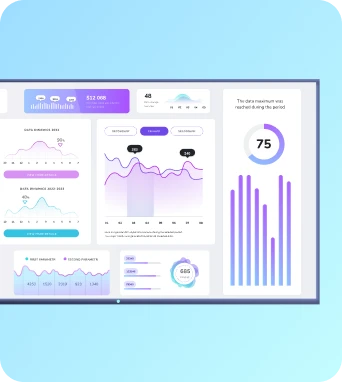AI-powered screen health monitoring
AI-powered screen health monitoring uses machine learning and edge or cloud analytics to continuously assess display performance, detect faults such as dead pixels, colour drift, brightness loss, and connectivity issues, and trigger automated remediation or alerts across digital signage and TV dashboard networks to minimise downtime and maintain visual quality.
What is AI-powered screen health monitoring?
Predictive analytics and anomaly detection for display performance
A technical aspect central to AI-powered screen health monitoring is the combination of time-series telemetry and anomaly detection algorithms tuned for display-specific signals. Players and displays emit a variety of telemetry: panel luminance and colour sensor readings where available, GPU and CPU utilisation, frame drop counts, HDMI handshake logs, ambient temperature from onboard sensors, power draw, and software-level logs such as media decoder errors and watchdog restarts. Feeding these heterogeneous streams into a time-series database or message bus enables feature extraction such as rolling averages, frequency-domain transforms for flicker detection, and delta changes aligned to content playback. Anomaly detection models—ranging from statistical baselines with dynamic thresholds to unsupervised approaches like isolation forests or autoencoders—can then be trained to flag deviations that precede visible faults. For example, a gradual decline in measured luminance combined with rising panel temperature might be modelled as a precursor to backlight failure, while intermittent HDMI negotiation failures correlated with certain content formats can reveal a decoder-driver compatibility issue. Implementation can be hybrid: lightweight models run on-device for low-latency detection and to reduce telemetry bandwidth, while more compute-intensive training and ensemble inference run in the cloud. Edge inference might evaluate per-frame checksum consistency to detect stuck pixels or use small convolutional networks on captured test patterns at scheduled intervals to assess colour uniformity; these images can be anonymised or downscaled for privacy and transmitted only as feature vectors. When a model flags an anomaly, the monitoring system enriches the event with contextual data—recent software updates, playlist hashes, neighbouring device behaviour—and applies rules or a secondary classifier to reduce false positives. Integration points with signage platforms such as Fugo.ai typically accept these enriched events via webhook or an API, enabling automated workflows: swap to a pre-configured fallback playlist, mark the screen as degraded in the console, or trigger a service ticket with attached diagnostic snapshots and suggested remediation steps. By combining device-side telemetry, tailored feature engineering, and layered anomaly detection, signage networks can move from reactive fix cycles to proactive, condition-based maintenance that preserves display quality and viewer experience.
Deploying and operating AI-driven monitoring at scale
Practical deployment of AI-powered screen health monitoring across a distributed signage estate begins with a clear telemetry strategy and lightweight on-device components. First, define the minimum viable telemetry set you need for meaningful models: timestamps, CPU/GPU load, memory, display-specific metrics (if the hardware exposes them), error counters from the player software, and periodic synthetic test-pattern captures if permissible. Choose efficient transport such as MQTT, secured WebSocket, or compressed periodic HTTP posts to a central collector; for constrained networks, aggregate and batch telemetry locally before transmission. A common pattern is to deploy a small agent on each player that performs local preprocessing: compute per-minute aggregates, run a compact anomaly detector for immediate triage, and buffer richer diagnostics for scheduled uploads or on-demand retrieval by technicians. When designing the cloud side, implement a time-series store and a stream-processing layer capable of enrichment and feature extraction. Model training can use historical labelled incidents plus simulated failure modes; where labelled data is sparse, consider semi-supervised learning and domain adaptation methods to generalise across device models. Monitor model drift by comparing detection rates and false positive rates across device cohorts and retrain periodically. Integration with platforms like Fugo.ai should include webhook endpoints and authentication, as well as mapping between asset IDs in the monitoring system and display records in the signage console so that alerts, content fallback and maintenance workflows are automated. Common pitfalls include overfitting models to a small set of devices, excessive sampling rates that overwhelm bandwidth or player CPU, and failing to account for environmental noise such as intentional brightness changes or maintenance activity that mimic faults. To mitigate these, establish baseline behaviour per site, use contextual metadata to suppress alerts during known events, and provide technicians with clear diagnostic artefacts—log extracts, recent playlist hashes, and test-pattern comparisons—to speed repair. Optimisation involves tuning sampling frequency, setting graduated alert levels, and implementing adaptive sampling where additional diagnostics are captured only when an initial anomaly is detected. For multi-tenant or geographically dispersed estates, incorporate role-based access controls and encrypted transport, and consider edge orchestration tools to roll out agent updates and new model binaries safely. Real-world use cases on platforms like Fugo.ai include automated content failover when a display reports degraded colour fidelity, proactive replacement scheduling for panels showing increasing pixel defects, and prioritised support routing that uses predicted failure windows to dispatch field engineers efficiently. Properly executed, deployment reduces mean time to detect and repair, lowers unnecessary site visits, and extends display lifetime through informed maintenance.
Final Thoughts on AI-powered screen health monitoring
Keep the learning going...
AI-powered content recommendations for signage
AI-powered content recommendations for signage use machine learning models to analyse audience, context, performance and content metadata, then automatically suggest or select the most relevant media for each screen. These systems reduce manual playlist curation, increase engagement by personalising content per location and time, and integrate with digital signage platforms like Fugo.ai for automated delivery.
AI-powered customer insights
AI-powered customer insights use machine learning and computer vision to analyse audience behaviour at digital signage touchpoints. They turn anonymised viewing data — dwell time, attention, footfall and engagement patterns — into actionable metrics that help operators optimise content, measure campaign ROI and improve in-store experience and signage performance.
All-in-one signage devices
All-in-one signage devices are compact displays with an integrated media player and operating system designed for digital signage. They reduce cabling, simplify rollouts and centralise management, making them well suited to TV dashboards and workplace displays that connect to platforms like Fugo.ai for content automation and remote monitoring.



